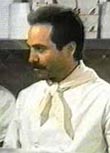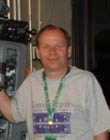|
|
 
|
|
Author
|
Topic: DTS Setup Disc
|
|
|
|
|
|
|
|
|
|
|
|
|
Steve Guttag
We forgot the crackers Gromit!!!

Posts: 12814
From: Annapolis, MD
Registered: Dec 1999
|
 posted 10-29-1999 10:59 AM
posted 10-29-1999 10:59 AM




>>"What does the weighting do?"<<Weighting alters the response of the meter.
In order to use pink-noise, the frequency range must be specified for the SPL reading to have any validity. The "C" weighting is flat in the pass-band of 20Hz - 20KHz and rolls off the response of the meter on either side of the pass-band. So the "weighting" in this case is in the audible spectrum while super-sonic and sub-sonic noises will not factor in to the overall SPL reading. It is one of the reasons SPL meters should not be used for setting subwoofer level, their response does not cover the weighted scale and in the case of "C" weighting, goes below. A much more accruate way of setting the subwoofer is to use a spectrum analyzer. This will also let one see the peaks and dips in the response and factor them in if they can't be tuned out with exisiting equipment. Steve
| IP: Logged
|
|
|
|
|
|
|
|
|
|
|
|
|
|
Leo Enticknap
Film God

Posts: 7474
From: Loma Linda, CA
Registered: Jul 2000
|
 posted 05-18-2017 09:39 AM
posted 05-18-2017 09:39 AM





Good solution. You'll find an assload of benefits from having an XD player. Given that most DTS use now is for repeated screenings of a few 70mm favorites, you can just ingest the audio from all of them and then forget about CDs (unless the hard drive dies - see below). AES digital out is a plus, too, and the reel countdown function on the display saves you from having to stand next to the projector for 3-4 minutes waiting for a changeover.
However, there are two gotchas (that I'm aware of).
1. At least some XD-10s had a model of motherboard that has a high failure rate from capacitor plague. It is possible to replace the capacitors (elsewhere on this forum Mark Gulbrandsen has described the procedure), but you need excellent disassembly/reassembly/soldering skills to even contemplate attempting it. I'd suggest looking at your motherboard to see if any of the capacitors are starting to bulge or otherwise look suspect; at least you'll have an early warning.
2. The XD-10 uses an IDE hard drive, not SATA. It will work with a SATA to IDE converter board (I'm running an XD-10 with a SATA drive connected this way, and have been for two years with no problems). I would make sure that you have either a spare, known good IDE drive in stock, or an IDE to SATA converter board plus a SATA drive.
The ideal insurance policy is two XD-10s, networked, and set so that they're always syncing the content between each other (i.e. anything you ingest into one is automatically copied over the LAN to the other immediately afterwards). In the event of one unit failing, all you have to do is to swap the reader and audio out cables to the other, and your show is back up. However, that would mean getting hold of another complete unit.
| IP: Logged
|
|
|
|
All times are Central (GMT -6:00)
|
|
Powered by Infopop Corporation
UBB.classicTM
6.3.1.2
The Film-Tech Forums are designed for various members related to the cinema industry to express their opinions, viewpoints and testimonials on various products, services and events based upon speculation, personal knowledge and factual information through use, therefore all views represented here allow no liability upon the publishers of this web site and the owners of said views assume no liability for any ill will resulting from these postings. The posts made here are for educational as well as entertainment purposes and as such anyone viewing this portion of the website must accept these views as statements of the author of that opinion
and agrees to release the authors from any and all liability.
|

 Home
Home
 Products
Products
 Store
Store
 Forum
Forum
 Warehouse
Warehouse
 Contact Us
Contact Us




 Printer-friendly view of this topic
Printer-friendly view of this topic














